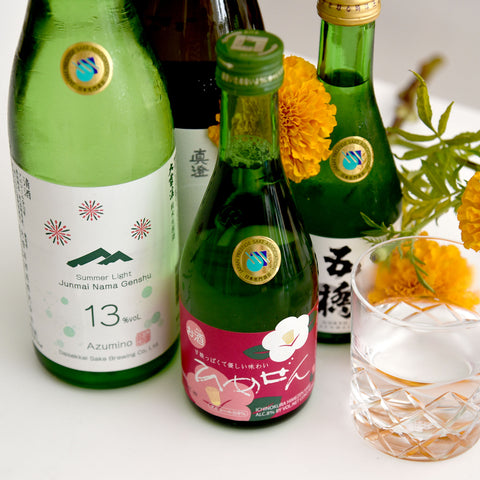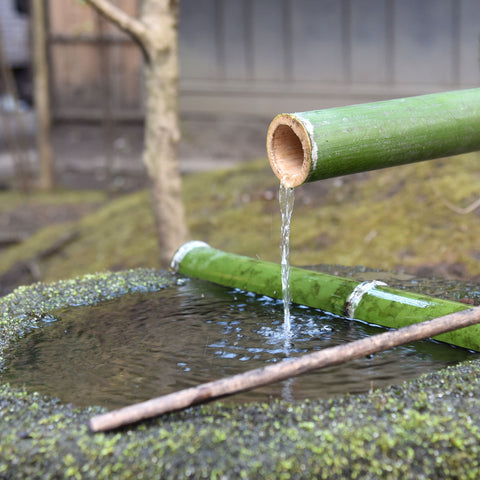Shochu Gumi is our quarterly subscription service with 80+ members throughout the country. Join today!
We are in peak produce season here in the Bay Area and I am constantly
inspired by all the radiant, bulbous fruit and vegetables that I find at the farmer’s
markets and Monterey Market in Berkeley. This is when all the colorful
tomatoes, cucumbers, peas, peaches, and berries thrive and call out to my
innate desire to create in the kitchen. Cooking is so calming and meditative for
me – we could all agree that making stuff by hand is so gratifying and brings
out our innermost childlike curiosities and imagination. With the acceleration of
technology and the need for convenience, we often overlook the need to slow
down and make something. Anything.
The shochus I’m featuring this quarter are tezukuri (handmade). Yes, there are
many honkaku shochus out there, made with care, batch by batch, which is
what makes this spirit category so special. Shochu really is Japan’s best kept
secret, and there are a countless number of bottles that could have been
chosen for this theme. However, these two shochus have been hand-picked by
me as ultra handmade bottles, and arduously imported by our vendors so they
can be Shochu Gumi exclusives. I am absolutely thrilled to finally get to share
them with you!
 Manzen Shuzo in the mountains of Kirishima
Manzen Shuzo in the mountains of Kirishima
Our first bottle Manzen Imo is being re-introduced to the U.S. market in the
720ml bottle size (formerly it was scantily available as an isshobin 1.8L bottle).
The koji is devoutly handmade, which is rare in shochu-making as this part is
usually mechanized.
 Making shochu by hand at Manzen Shuzo
Making shochu by hand at Manzen Shuzo
Secondly, Ichinojo Kokuto Shochu is made with homegrown, organic black sugar! This is extremely uncommon, given that most kokuto shochus are made with sugar grown in Okinawa. You’re going to really taste both the koji and the kokuto in these respective bottles and I hope you will take a minute to enjoy these tezukuri shochus (paired with home cooked dishes!).
 Asahi Shuzo Production Manager and owner Hiroyuki Kitei at the distillery’s organic sugarcane fields in Amami Oshima
Asahi Shuzo Production Manager and owner Hiroyuki Kitei at the distillery’s organic sugarcane fields in Amami Oshima
Kanpai,
Kayoko
+++

Manzen Imo Shochu
Manzen Shuzo (Kirishima, Kagoshima)
Distilled from Koganesengan sweet potatoes and local Hinohikari rice
ABV 25% / Koji: Black / Distillation: Atmospheric
Aged in ceramic for three months
Shochu Gumi Exclusive!
Manzen Shuzo has been located in the mountains of Kirishima for the past 150
years. The company was revived by the current fourth generation president
Toshihiro Manzen and they make three shochus (one for each kind of koji) with the
pristine Kirishima rekka sui – waters full of volcanic minerals. Fermentation occurs
for about two weeks in the traditional kamejikomi style (in vats made out of
ceramic) and they use a finicky, labor-intensive wooden still for distillation. The
only mechanized step occurs in the steaming of the rice to make the koji.
 Koganesengan potatoes at Manzen
Koganesengan potatoes at Manzen
 Adding steamed sweet potato to the moromi
Adding steamed sweet potato to the moromi
 Stills made of sugi (Japanese cedar)
Stills made of sugi (Japanese cedar)
Toji Hiroyuki Manzen says that the koji is the most important step for his shochu-making, "For half the year, I stay overnight in the brewery and take care of the koji."
 Manzen toji Hiroyuki Manzen
Manzen toji Hiroyuki Manzen
Hiroyuki-san recommends this shochu oyuwari (at 95 ̊F) with roast beef or torisashi (chicken sashimi), while I enjoyed it on the rocks or mizuwari with a summer vegetable ratatouille or Pollo a la Catalan (chicken braised with wine and dried fruits) from the recent issue of Milk Street.
 Chicken sashimi is the recommended pairing for Manzen Imo
Chicken sashimi is the recommended pairing for Manzen Imo
These dishes greatly complemented the fruity (think Hawaiian Fruit Punch!) yet earthy, minerally notes of the shochu. Fun fact: Hawaiian Shochu Company’s Ken Hirata apprenticed at Manzen before opening his distillery on Oahu.
+++

TIDA Ichinojo Kokuto Shochu
Asahi Brewery (Amami Oshima, Kagoshima)
Distilled from estate organic kokuto (black sugar) and Thai rice
ABV 25% / Koji: Black / Distillation: Atmospheric
Aged in enamel tanks for 1-2 years
Shochu Gumi Exclusive!
Since 1916, Asahi Shuzo has been making kokuto shochu and they now grow their kokuto and rice organically on their own farm on Kikaijima, the eastern most
islands on the Amami archipelago.
 Asahi Shuzo in the springtime
Asahi Shuzo in the springtime
Ichinojo is made with 2.5 times the amount of sugar that is normally used for their flagship bottle. Production Manager Hiroyuki Kitei says they change the production depending on the condition of the raw materials and state of fermentation. A sip of Ichinojo is like taking a nose-dive into a bowl of dark raw kokuto sugar, with notes full of chocolate, purple fruit, custard, and roasted bananas. I love this with soda with hiyashi chuka (ramen salad) or a smothered porkchop with my father-in-law’s beans (ask me for the simple recipe!). Or have a nightcap on the rocks with a piece of dark chocolate. This bottle debuted in 2001, and Kitei-san named it Ichinojo (first brew) since it was his first release. All labels are handwritten by Kitei-san.
 Raw sugarcane grown organically at Asahi Shuzo
Raw sugarcane grown organically at Asahi Shuzo




Comments (0)
There are no comments for this article. Be the first one to leave a message!